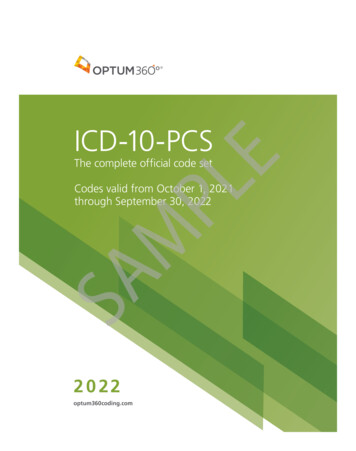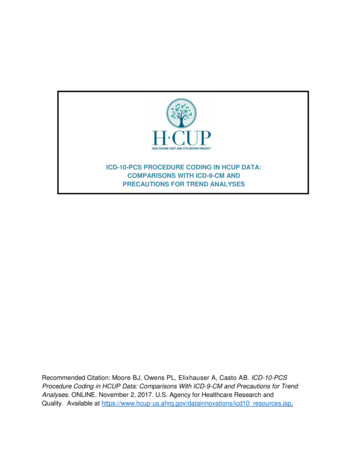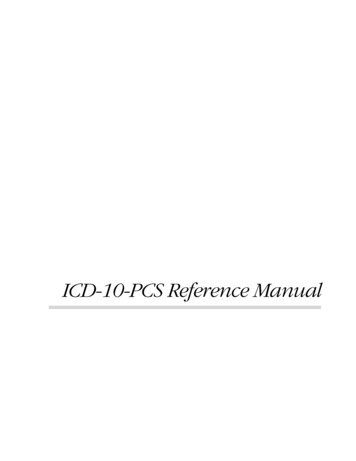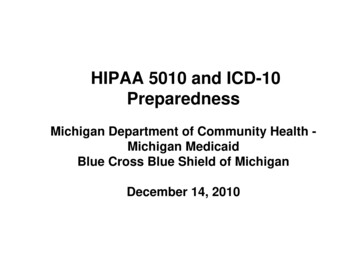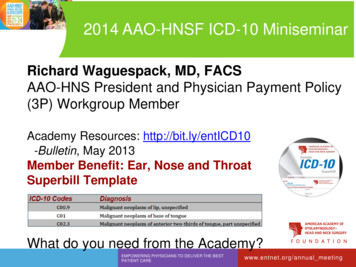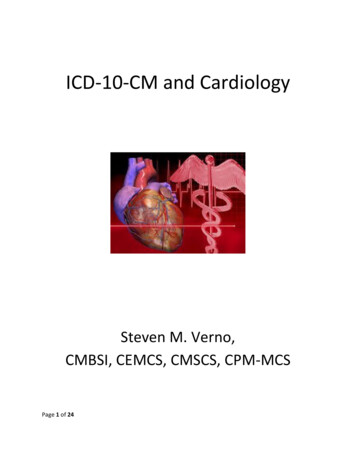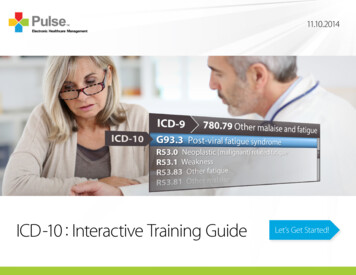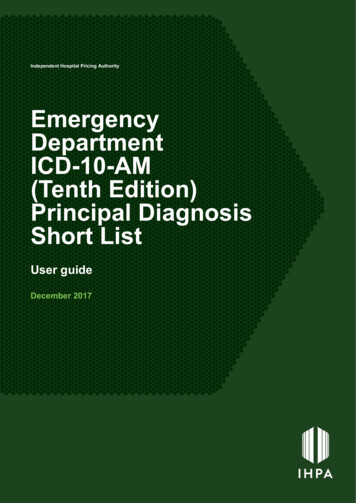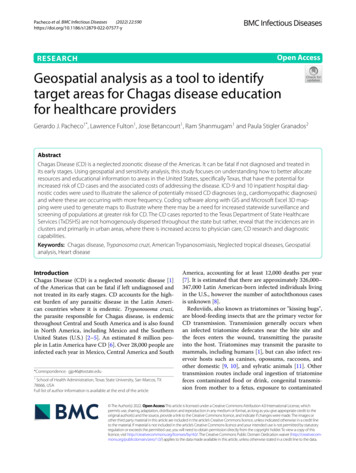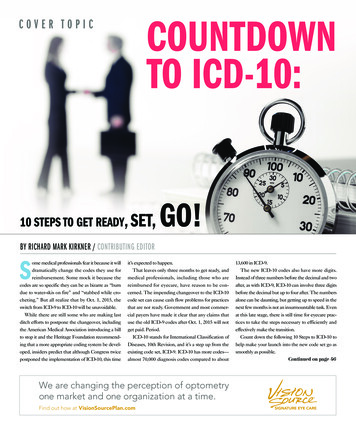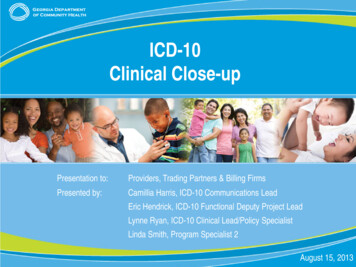
Transcription
Basic ICD-10-CM/PCSCoding2013 EditionAnswer KeyLou Ann Schraffenberger, MBA, RHIA, CCS, CCS-P, FAHIMA
Answer KeyThe answer key includes the correct ICD-10-CM/PCS codes and the Alphabetic Index entry used tolocate each code.Chapter 1Introduction to ICD-10-CM4.5.Exercise 1.11.N63Mass, breast2.N13.30 Hydronephrosis (primary)3.J34.2 Deviated, nasal septum4.R59.0 Adenopathy, inguinal5.I25.10 Disease, arteriosclerotic—seeDisease, heart, ischemic, atherosclerotic.Arteriosclerotic heart—see Arteriosclerosis,coronary (artery)6.G44.209 Headache, tension7.K85.9 Pancreatitis (suppurative)8.K00.6 Eruption, tooth abnormal(premature)9.I33.0 Endocarditis, infectious10.I08.0 Endocarditis, mitral with aortic(valve) disease, active or acuteExercise 1.21.Nonessential modifier congenitalQ67.8 Distortion (congenital) chest (wall)2.Nonessential modifier acuteK57.32 Diverticulitis (acute) intestine, large3.Nonessential modifier bleedingK64.4 Hemorrhoids external4.Nonessential modifier cardiacR01.0 Murmur (cardiac) functional5.Nonessential modifier chronicJ32.0 Sinusitis (chronic) maxillaryExercise 1.31.Main term EndomyometritisN71.0 Endomyometritis—see Endometritis,acute2.Main term MetrorrhexisN85.8 Metrorrhexis—see Rupture, uterus,nontraumatic3.Main term OsteoarthrosisM19.019 Osteoarthrosis—see alsoOsteoarthritis, shoulder, M19.01(unspecified M19.019)Main term ProlapseM50.20 Prolapse—see Displacement,intervertebral disc, cervicalMain term StenosisN88.2 Stenosis, endocervical—see StenosiscervixExercise 1.41.A41.9 Sepsis NOS2.A49.8 Infection, bacteroides NEC3.I31.9 Pericarditis (with effusion)4.B08.3 Disease, fifthTabular List—B08.3—Erythemainfectiosum [fifth disease]5.Dementia, with, Lewy bodies G31.83[F02.80]See the "Use additional code" note undercategory G31Use additional code to identify dementiawith behavioral disturbance (F02.81)Use additional code to identify dementiawithout behavioral disturbance (F02.80)Exercise 1.51.Intrahepatic bile duct2.Diabetes mellitus arising in pregnancyGestational diabetes mellitus3.Anorexia nervosa4.Blackout, Fainting, Vasovagal attack5.Diverticulum of appendixExercise 1.61.I85.11 Varix, esophagus, in, cirrhosis ofliver, bleeding2.N39.0 Infection, urinary (tract)Use additional code (B95–B97) to identifyinfectious agentB96.20 Infection, Escherichia coli as causeof disease classified elsewhere3.K26.0 Ulcer, duodenum, acute, withhemorrhage4.P61.2 Anemia, due to, prematurity5.Z04.1 Examination, following, motorvehicle accident
Review Exercises: Chapter 0.K35.2 Appendicitis, acute, with perforationJ15.4 Pneumonia, streptococcal NECR07.2 Pain, chest, precordialI26.09 Cor, pulmonale, acuteM19.071 Osteoarthrosis—see Osteoarthritis,primary, ankle, rightE05.20 Goiter, nodular, toxicQ89.2 Extra—see Accessory, thyroidK55.21 Angiodysplasia (colon) withbleedingJ20.9 Tracheobronchitis—see alsoBronchitis, acuteI25.119 Disease, heart, arteriosclerotic—seeDisease, heart, ischemic, atheroscleroticwith angina pectoris—see Arteriosclerosis,coronary (artery) native vessel with anginapectorisM32.14 Nephritis, due to, systemic lupuserythematosusZ34.02 Prenatal, care, normal firstpregnancy—see Pregnancy, normal, first,second trimesterS72.142A Fracture, femur, upper end,intertrochanteric, left The coder must see theTabular List for assignment of the left sideand the seventh character “A” for the closedfracture, initial encounter to identify theencounter.A59.02 Prostatitis, trichomonalI63.239 Occlusion, artery, carotid, withcerebral infarctionI10Hypertension (essential)B17.11, Hepatitis, C, acute, with hepaticcomaC91.01, Leukemia, acute lymphoblastic, seeTabular List for sixth character for inremissionD3A.020, Tumor, carcinoid, benign,appendixN40.1, Enlarged, prostate, with lowerurinary tract symptoms (urinary obstruction)N13.8 verified in Tabular List under codeN40.1N13.8 Obstruction, urinary, specified.Inclusion notes under N13.8 state urinaryobstruction due to specified cause and thereis a “code first” note present to code thecausal condition such as enlarge prostateCorrected from Alphabetic Index: N13.9,Obstruction, urinaryZ85.3, History, personal, malignantneoplasm (of), breast
Chapter 2Introduction to ICD-10-PCSReview Exercises: Chapter 21. Answer: ionBody Part0Approach8DeviceQualifierZZExplanationMedical and SurgicalGastrointestinal SystemInspectionQualifierUpper Intestinal TractVia Natural or ArtificialOpening EndoscopicNo DeviceNo QualifierINDEX: Root Operation: Inspection. Index:Esophagogastroduodenoscopy (0DJ08ZZ)In this example, the complete sevencharacter code is listed in the Index. Thecode still must be confirmed using the codeTables. EGD is an inspection procedurewhen no other procedures, such as a biopsyor excision, are performed with the EGD.Body part inspected is the upper intestinaltract. Approach is through the mouth so “vianatural or artificial opening endoscopic” isthe choice for this procedure.2. Answer: 0HBU0ZZCharacterCodeSection0Body System HRootBOperationBody PartUApproach0DeviceZQualifierZ3. Answer: ionBody PartLApproach0DeviceKExplanationMedical and SurgicalSkin and BreastExcisionBreast, LeftOpenNo DeviceNo QualifierINDEX: When consulting the Index, the main termMastectomy has two subterms: see Excision,Skin and Breast and see Resection, Skin andBreast. Since only part of the breast wasremoved, the root operation is Excision.LExplanationMedical and SurgicalLower ArteriesBypassFemoral Artery, LeftOpenNonautologous TissueSubstitutePopliteal ArteryINDEX: When consulting the Index, the main termBypass, subterm Artery, Femoral producedthe root operation table of 041. According toICD-10-PCS guideline B3.6a.Bypassprocedures: Bypass procedures are coded byidentifying the body part bypassed “from”and the body part bypassed “to”. The fourthcharacter body part specifies the body partbypassed from, and the qualifier specifies thebody part bypassed to. In this example, thebypass was “from” the femoral artery “to” thepopliteal artery. A cadaver vein graft is thedevice identified as nonautologous (fromanother human than patient) tissue substitute.4. Answer: ionBody Part2Approach4DeviceZQualifierZExplanationMedical and SurgicalFemale ReproductiveSystemReleaseOvaries, BilateralPercutaneous EndoscopicNo DeviceNo QualifierINDEX:Lysis see Release. Release, Ovaries,Bilateral (0UN2) Definition of release inICD10-PCS is freeing a body part from anabnormal physical constraint which alsodescribes a procedure identified as lysis. Twocodes are required for this procedure as thesame root operation is performed on differentbody parts as defined by distinct values of thebody part character for the root operation
“release.” Laparoscopy is an approach that ispercutaneous endoscopicAnswer: ionBody Part7Approach4DeviceZQualifierZExplanationMedical and SurgicalFemale ReproductiveSystemReleaseFallopian Tubes, BilateralPercutaneous EndoscopicNo DeviceNo QualifierINDEX:Lysis see Release. Release, FallopianTubes (0UN7)5. Answer: 0SG10A1CharacterCodeSection0Body System SRootGOperationBody Part1ApproachDeviceQualifier0A1ExplanationMedical and SurgicalLower JointsFusionLumbar Vertebral Joints, 2or moreOpenInterbody Fusion DevicePosterior Approach,Posterior ColumnINDEX:Root operation is fusion. Index: Fusion,lumbar vertebrae 2 or more (0SG1). According tothe ICD-10-PCS guideline for fusion procedures ofthe spine, B3.10a: The body part coded for a spinalvertebral joint(s) rendered immobile by a spinalfusion procedure is classified by the level of thespine (e.g. thoracic). There are distinct body partvalues for a single vertebral joint and for multiplevertebral joints at each spinal level. According toguideline B3.10.c if an interbody fusion device isused to render the joint immobile (alone orcontaining other material like bone graft), theprocedure is coded with the device value InterbodyFusion Device. The qualifier identifies thecombination of the approach and the column.6. Answer: 0TP98DZCharacterCodeSection0Body System TRootPOperationBody Part9Approach8DeviceQualifierDZExplanationMedical and SurgicalUrinary SystemRemovalUreterVia Natural or ArtificialOpening EndoscopicIntraluminal DeviceNo QualifierINDEX:Root Operation: Removal. Index:Removal of device from, Ureter (0TP9)The objective of the procedure was to take the stentout of the ureter which matches the definition of“removal” to take out of off a device from a bodypart. The approach is by cystoscopy or via natural orartificial opening (urethra) endoscopic. A stent is anintra-luminal device which are devices placed insidetubular body parts.7. Answer: ionBody PartJApproach0DeviceZQualifierZExplanationMedical and SurgicalAnatomical Region, UpperExtremitiesReattachmentHand, RightOpenNo DeviceNo QualifierINDEX:Root Operation: Reattachment. Index:Reattachment, Hand, Right (0XMJ0ZZ) Indexprovides a specific code for this operation. The onlyvariable on the Table is the body part beingreattached.8. Answer: ionBody PartGApproach3DeviceZQualifierXExplanationMedical and SurgicalAnatomical Regions,GeneralDrainagePeritoneal CavityPercutaneousNo DeviceDiagnosticINDEX: Root Operation: Drainage Index:Paracentesis, Peritoneal Cavity see Drainage,
Peritoneal Cavity (0W9G) The Index includes theprocedure of paracentesis to send the coder directlyto the correct coding Table. The approach isdescribed as percutaneous and the procedure isidentified as “diagnostic” so that the qualifier “X” isused.six characters leaving the coder to select the qualifierto identify the type of transplant. The ICD-10-PCSReference Manual describes transplantation as“allogeneic” for a human donor, “syngeneic” foridentical twin donor, and “zooplastic” for animal asthe source of the organ.9. Answer: ionBody PartMApproach0DeviceZQualifier911. Answer: 0DQE0ZZCharacterCode ExplanationSection0Medical and SurgicalBodyDGastrointestinal SystemSystemRootQRepairOperationBody PartELarge IntestineApproach0OpenDeviceZNo DeviceQualifierZNo QualifierExplanationMedical and SurgicalAnatomical Region, LowerExtremitiesDetachmentFoot, RightOpenNo DevicePartial 1st RayINDEX: Amputation—see Detachment. RootOperation: Detachment. Index: Detachment, Foot,Right (0Y6M0Z). The Index gives the codereverything except character 7 for the qualifier. Thechoices for the qualifiers listed are complete,complete 1st thought 5th ray, partial and partial 1stthought 5th ray. Complete is defined as amputationthrough the carpometacarpal (hand) or throughtarsal-metatarsal (foot). Partial is amputationanywhere along the shaft or head of the metacarpal(hand) or metatarsal (foot). The fingers or toes are1st thought 5th rays. In this example, the right bigtoe is the 1st ray. Transmetatarsal is a partialamputation.The definition of the detachment qualifiers areincluded in the ICD-10-PCS Reference Manual,which can be found as a download -10-PCS-GEMs.html10. Answer: ionBody Part1Approach0DeviceZQualifier0ExplanationMedical and SurgicalUrinary SystemTransplantationKidney, LeftOpenNo DeviceAllogeneicINDEX:Root Operation: Transplantation. Index:Transplant, Kidney, Left (0TY10Z) The Index givesINDEX:Root Operation: Repair. Index: Repair,Intestine, Large (0DQE) The term “repair” is definedas restoring to the extent possible, a body part to itsnormal anatomic structure and function. Often theterm “repair” involves a suture repair which needs tobe confirmed in the operative report. The Indexincludes the term “Suture, laceration repair, seeRepair.” If the operative report described thelocation more precisely, the body part charactercould change.
12. Answer: 0QSG0ZZCharacterCodeSection0Body System QRootSOperationBody PartGApproach0DeviceZQualifierZExplanationMedical and SurgicalLower BonesRepositionTibia, RightOpenNo DeviceNo QualifierINDEX:Root Operation: Reposition. Index:Reduction, fracture, see reposition. Reposition,Tibia, Right (0QSG). There is no device used forthis question because no fixation device is includedin the procedure title. The device character wouldchange depending on the type of fixation device use,if any.13. Answer: ionBody PartGApproach0Device8QualifierZExplanationMedical and SurgicalHeart and Great VesselsReplacementMitral ValveOpenZooplastic TissueNo QualifierINDEX:Root Operation: Replacement. Index:Replacement, Valve, Mitral (02RG) The coder needsto complete the code with the approach (open), thedevice (porcine which is animal or zooplastic tissue)and the default “Z” for no qualifier .14. Answer: ionBody Part0Approach3DeviceZQualifierZExplanationMedical and SurgicalHeart and Great VesselsDilationCoronary Artery, One SitePercutaneousNo DeviceNo QualifierINDEX: Root Operation: Dilation. Index:Angioplasty—see Dilation, Heart and Great Vessels.Index: Dilation, artery, coronary, one site (0270)Also the option “PTCA” see Dilation, Heart andGreat Vessels (027) The coding of a PTCAprocedure depends on coronary artery lesion sites(See guideline B4.4) involved (body part), theapproach (usually percutaneous) and whether or nota stent (and what type) is used for the devicecharacter. Bifurcation for a qualifier option is toidentify when a procedure is performed at site of avessel’s bifurcation.
15. Answer: 0D5N8ZZCharacterCode ExplanationSection0Medical and SurgicalBodyDGastrointestinal SystemSystemRoot5DestructionOperationBody PartNSigmoid ColonApproach8Via Natural or ArtificialOpening EndoscopicDeviceZNo DeviceQualifierZNo QualifierINDEX:Root Operation: Destruction. Index:Fulguration—see Destruction. Destruction, colon,sigmoid (0D5N.) Usually, a procedure like thisexample is titled colonoscopy with fulguration ofpolyp. The coder must complete the code with theapproach (endoscopic via natural opening to reach acolonic polyp) and there is no option for a device ora qualifier.16. Answer: 05CD0ZZCharacterCodeSection0Body System 5RootCOperationBody PartDApproach0DeviceZQualifierZExplanationMedical and SurgicalUpper VeinsExtirpationCephalic Vein, RightOpenNo DeviceNo QualifierINDEX:Root Operation: Extirpation.Thrombectomy-see Extirpation. Index: Extirpation,Vein, Cephalic, Right (05CD) Again, the coder mustcomplete the coder with the approach (open byincision) but no options for device or qualifier.17. Answer: 0SWD0JZCharacterCodeSection0Body System SRootWOperationBody PartDApproach0DeviceJQualifierZExplanationMedical and SurgicalLower JointsRevisionKnee Joint, LeftOpenSynthetic SubstituteNo QualifierINDEX:Root Operation: Revision. Index:Revision of device in, joint, knee, left (0SWD)Coderneeds to complete 5th character for approach (open),6th character for device (joint prosthesis are metal orceramic, which are synthetic substitutes for the joint)and no option for qualifier
18. Answer: 0UDB8ZXCharacterCode ExplanationSection0Medical and SurgicalBodyUFemale dy PartBEndometriumApproach8Via Natural or ArtificialOpening EndoscopicDeviceZNo DeviceQualifierXDiagnostic20. Answer: ionBody Part4Approach8INDEX:Root Operation: Extraction. Index:Curettage—see Excision, see Extraction Theobjective of the procedure, D&C, is a curettage ofthe endometrium. A curettage is not an excisionprocedure. It is a pulling or stripping out or off all ofa body part by the use of force which is thedefinition of extraction. Extraction, Endometrium(0UDB). Hysteroscopy for the approach is anendoscopic procedure through a natural opening toreach the endometrium. Qualifier X used as theprocedure is described as diagnostic.INDEX:Root Operation: Division. Index:Esophagotomy see Division, EsophagogastricJunction (0D84). The root operation of division isdefined as cutting into a body part without drainingfluids and/or gases from the body part in order toseparate or transect a body part. Anesophagomyotomy is a procedure to cut into theesophagus muscle. The approach, an EGD, isendoscopic procedure through a natural orifice.There is no option for a device or qualifier.19. Answer: ionBody Part6ApproachXDeviceZQualifierZExplanationMedical and SurgicalUrinary SystemFragmentationUreter, RightExternalNo DeviceNo QualifierINDEX: Root Operation: Fragmentation. Index:Lithotripsy see Fragmentation, Ureter, Right (0TF6)Body part involved is the right ureter. An alternateindex entry—Extracorporeal shockwavelithotripsy—see Fragmentation. Extracorporealshock wave lithotripsy (ESWL) is the most commontype of lithotripsy. "Extracorporeal" means outsidethe body. Lithotripsy is an external procedure as theshockwaves enter through the body, not through anincision or orifice. Approach is therefore external.The code is completed using the default Z for nodevice and no qualifier.DeviceQualifierZZExplanationMedical and SurgicalGastrointestinal SystemDivisionEsophagogastric JunctionVia Natural or ArtificialOpening EndoscopicNo DeviceNo Qualifier21. Answer: 0HXKXZZCharacterCode ExplanationSection0Medical and SurgicalBodyHSkin and BreastSystemRootXTransferOperationBody PartKSkin, Right Lower LegApproachXExternalDeviceZNo DeviceQualifierZNo QualifierINDEX:Root Operation: Transfer. Index:Transfer, skin, lower leg, right (0HXKXZZ) Indexgives the coder the seven characters to verify in thecode Table. Any procedure done on skin is anexternal procedure.22. Answer: 02VQ0CZCharacterCode ExplanationSection0Medical and SurgicalBody2Heart and Great VesselsSystemRootVRestrictionOperationBody PartQPulmonary Artery, RightApproach0OpenDeviceCExtraluminal DeviceQualifierZNo Qualifier
INDEX: Root Operation: Restriction. Index:Banding—see Restriction, Artery, Pulmonary, Right(02VQ.) The root operation “restriction” is definedas partially closing an orifice or the lumen of atubular body part. A banding procedure puts adevice on a tubular body part to partially close thelumen. Approach is open as a thoracotomy. Deviceis specified in procedure title as an extraluminaldevice that is the actual banding of the vessel.Extraluminal—outside the tube/vessel.23.23. Answer: ionBody PartEApproach3DeviceDQualifierTExplanationMedical and SurgicalLower ArteriesOcclusionInternal Iliac Artery, RightPercutaneousIntraluminal DeviceUterine Artery, RightINDEX:Root Operation: Occlusion. Index:Embolization—see Occlusion, artery, internal iliac,right uterine artery, right (04LE) There is no entry inthe Index for artery, uterine. Using the Body PartKey, the uterine artery is used as the internal iliacartery for the body part character. The Device Key isused to identify that embolization coil is anintraluminal device for the device character. TheQualifier “T” identifies the uterine artery as the siteof the procedure.24. Answer: 0W4M0K0CharacterCode ExplanationSection0Medical and SurgicalBodyWAnatomical Regions, GeneralSystemRoot4CreationOperationBody PartMPerineum, MaleApproach0OpenDeviceKNonautologous TissueSubstituteQualifier0VaginaINDEX:Creation. The coder must know thedefinition of the root operations so that the rootoperation of “creation” is accessed in the Index.Index: Creation, male, should be used as it is a malepatient having the procedure. The body part of themale where the procedure is performed is theperineum. The device of tissue bank donor materialis nonautologous or other human tissue. TheQualifier identifies that a vagina is being created.25. Answer: ionBody PartVApproach0DeviceJQualifierZExplanationMedical and SurgicalSkin and BreastAlterationBreast, BilateralOpenSynthetic SubstituteQualifierINDEX:Root Operation: Alteration. Coder mustrecognize this is a cosmetic procedure, therefore, theroot operation is alteration. Index: Alteration, breast,bilateral (0H0V) The silicone implants are thedevice which is a synthetic substitute.26. Answer: 00HV3MZCharacterCode ExplanationSection0Medical and SurgicalBody0Central Nervous SystemSystemRootHInsertionOperationBody PartVSpinal CordApproach3PercutaneousDeviceMNeurostimulator LeadQualifierZNo QualifierINDEX: Root Operation: Insertion. Index: Insertionof device in, spinal cord (00HV). The device is aneurostimulator which is inserted into lumbar spinalcord by percutaneous approach.27. Answer: 0UUG0JZCharacterCode ExplanationSection0Medical and SurgicalBodyUFemale Reproductive SystemSystemRootUSupplementOperationBody PartGVaginaApproach0OpenDeviceJSynthetic SubstituteQualifierZNo QualifierINDEX:Root Operation: Supplement. Index:Colporrhaphy see Repair, Vagina (0UQG) Whenreviewing this table, coder will note there is nodevice character to identify the mesh used. So this is
not the correct root operation. The definition ofsupplement is putting in or on biological or syntheticmaterial that physically reinforces and/or augmentsthe function of a portion of a body part. Theinsertion of mesh is a “supplement” procedure thatreinforces the structure of the body part. The Indexentry to be used is Supplement, vagina (0UUG).Mesh is a synthetic product.28. Answer: 0B21XFZCharacterCode ExplanationSection0Medical and SurgicalBodyBRespiratory SystemSystemRoot2ChangeOperationBody Part1TracheaApproachXExternalDeviceFTracheostomy DeviceQualifierZNo QualifierINDEX:Root Operation: Change. Index:Exchange see Change device in, trachea (0B21). Anexchange procedure is removing and reinserting thesame or similar device into the same location. Atracheostomy tube exchange involved a device in thetrachea. The approach is external the tracheostomyopening is accessed directly at the skin level.29. Answer: ionBody Part0Approach0DeviceZQualifierZExplanationMedical and SurgicalCentral Nervous SystemMapBrainOpenNo DeviceNo QualifierINDEX:Root Operation: Map. Index: Map,brain (00K0). The approach is open as described bythe craniotomy. There is no device left in the bodyafter the procedure and no qualifier listed on thecode table.30. Answer: 0W3G0ZZCharacterCode ExplanationSection0Medical and SurgicalBodyWAnatomical Regions,SystemGeneralRoot3ControlOperationBody PartGPeritoneal CavityApproach0OpenDeviceZNo DeviceQualifierZNo QualifierINDEX:Root Operation: Control. The procedureis identified as a control of postoperative bleeding.Index: Control, postprocedural bleeding in,peritoneal cavity (0W3G). The approach is open asdescribed by laparotomy. The body part where theprocedure is performed is the peritoneal cavitywhere the bleeding occurred.
Chapter 3Introduction to theUniform Hospital Discharge Data Setand Official ICD-10-CM CodingGuidelinesReview Exercises: Chapter 31. To establish a minimum common core of data tobe collected on individual acute care short termhospital discharges in Medicare and Medicaidprograms. UHDDS sought to improve the uniformityand comparability of hospital discharge data. Allnon-outpatient settings including acute care, shortterm care, long term care, and psychiatric hospitals,home health agencies, rehabilitation facilities, andnursing homes.2. The condition established after study to bechiefly responsible for occasioning the admission ofthe patient to the hospital for care.3. Conditions that coexist at the time of admission,that develop subsequently, or that affect the treatmentreceived and/or the length of stay. Diagnoses are tobe excluded that relate to an earlier episode that hasno bearing on the current hospital stay.4. . A complication is an additional diagnosis thatdescribes a condition arising after the beginning ofthe hospital observation and treatment and thenmodifying the course of the patient’s illness or themedical care required. A comorbidity is an additionaldiagnosis that describes a preexisting condition thatbecause of its presence with a specific principaldiagnosis will likely cause an increase in the patient’slength of stay in the hospital.5 . Grand total of 22.18 Diagnosis codes 3 E codes 1 admittingdiagnosis code6 . 6 procedure codestwo diagnoses equally meet the definition ofprincipal diagnosis.10 .Principal diagnosis could be either acutepancreatitis or acute cholangitis as both areunconfirmed diagnosis and could explain thepatient’s symptoms. Because there are no specificsymptoms noted, either acute pancreatitis or acutecholangitis may be listed as the principal diagnosis.11 .Principal diagnosis is left lower quadrantabdominal pain. The diagnoses of ruptured ovariancyst and acute salpingitis are coded as additionaldiagnoses.12 .Principal diagnosis is osteoarthritis of knee.Additional codes for hypertensive heart disease andcode for surgical or other procedure not carried outbecause of contraindication, would be assigned.13 .Principal diagnosis is postoperative woundinfection. An additional diagnosis for diverticulitis isassigned.14 .Principal diagnosis is viral pneumonia.15 .Principal diagnosis is status asthmaticus16 .Principal diagnosis is orthostatichypotension. An additional diagnosis code forcataract is also assigned. The procedure of thecataract extraction is also coded.17 .The other diagnoses of cholelithiasis andtype II diabetes are coded. The history of pneumoniaand status post bunionectomy are unrelated to thishospital stay, are historical events, and therefore notcoded.18 .The other diagnoses of hypertension andbenign prostatic hypertrophy are coded. No otherdiagnoses codes for the findings from the laboratoryreports should be assigned without asking thephysician if the abnormal findings are significant.7 . Principal diagnosis seizure19 .In addition to the gastritis, both the acuteduodenitis and acute pancreatitis should be coded.8 . Principal diagnosis could be either acutepyelonephritis or acute cystitis as there are interrelated conditions (same ICD-9-CM chapter) andboth were treated during the hospital stay.20 .The urinary retention would be reported with“N” for no, condition not present on admission.9 . Principal diagnosis could be either acuteexacerbation of COPD or acute low back pain as the
Chapter 4Certain Infectious and ParasiticDiseasesReview Exercises: Chapter 41.N39.0, Infection, urinary tractB96.4, Infection, bacterial, NOS, as cause ofdisease classified elsewhere, Proteus(mirabilis)The “Use additional code’ note under N39.0instructs the coder to an additional code(B95–B97) to identify the infectious agent.2.A04.7, Colitis, Clostridium difficileZ16.24, Resistance, to multiple drugs(MDRO) antibioticsICD-10-CM provides a code to identify drugresistant organisms (Z16). The “useadditional code” note is found at thebeginning of Chapter 1.3.A02.9, Poisoning, food, bacterial—seeIntoxication, foodborne, due to SalmonellaAnother entry is Poisoning, food, due to,Salmonella.Food poisoning is classified to Chapter 1,Certain infectious and parasitic disease(A00–B99). If gastroenteritis is documented,then the code would change to A02.0.4.A56.11, Salpingitis, chlamydial5.B20, AIDSC46.0 Sarcoma, Kaposi's, skin (multiple)6.A41.81 Sepsis, EnterococcusK57.40 Diverticulitis, intestine, large,with small intestine, with perforation7.A41.3 Sepsis, Haemophilus influenzaeR65.21 Sepsis, severe, with septic shockN17.9 Failure, renal acute8.A37.01 Whooping cough, due toBordetella, pertussis, with pneumonia9.B16,2 Hepatitis, B, acute, with, hepaticcoma10.B37.81, Esophagitis, candidalA combination code exists in ICD-10-CM toidentify the myotic condition of candidiasisoccurring in the esophagus and causing anesophagitis condition.11. PROCEDURE: Insertion of multilumen centralvenous catheter into the right subclavian vein forintravenous infusion by percutaneous approachCharacterCode ExplanationSection0Medical and SurgicalBody5Upper VeinsSystemRootHInsertionOperationBody Part5Subclavian Vein, RightApproach3PercutaneousDevice3Infusion DeviceQualifierZNo QualifierINDEX: Insertion of device in, vein, subclavian,right 05H512. PROCEDURE: Exploratory laparotomy andsmall-bowel resection of 50 cm portion of thejejunum with side-to-side, functional end-to-endsewn anastomosis of the jejunum. The patient hasperitonitis and a twisted nonviable small bowel.CharacterCode ExplanationSection0Medical and SurgicalBodyDGastrointestinal SystemSystemRootBExcisionOperationBody PartAJejunumApproach0OpenDeviceZNo DeviceQualifierZNo QualifierINDEX: Excision, jejunum 0DBA. The physicianstates resection but according to the definition of theroot operations resection and excision, this operationis an excision because only a portion of the smallbowel/jejunum. The approach is open as stated byexploratory laparotomy. Anastomosis should not beassigned separately. New coding guideline in 2013.B3.1b Components of a procedure specified in theroot operation definition and explanation are notcoded separately. Procedural steps necessary toreach the operative site and close the operative site,including anastomosis of a tubular body part, arealso not coded separately. Example: Resection of ajoint as part of a joint replacement procedure isincluded in the root operation definition ofReplacement and is not coded separately.Laparotomy performed to reach the site of an openliver biopsy is not coded separately. In a resection of
sigmoid colon with anastomosis of descending colonto rectum, the anastomosis is not coded separately.13. PROCEDURE: Insertion of venous accessdevice/port percutaneously into the subclavian veinadvanced to the superior vena cava with a pocket forthe port placed in the subcutaneous tissue of thechest wall for chemotherapy to treat coloncarcinoma. An incision is made to create the pocket.CharacterCo
the ICD-10-PCS guideline for fusion procedures of the spine, B3.10a: The body part coded for a spinal vertebral joint(s) rendered immobile by a spinal fusion procedure is classified by the level of the spine (e.g. thoracic). There are distinct body part values for a single vertebral joint and for multiple vertebral joints at each spinal level.
